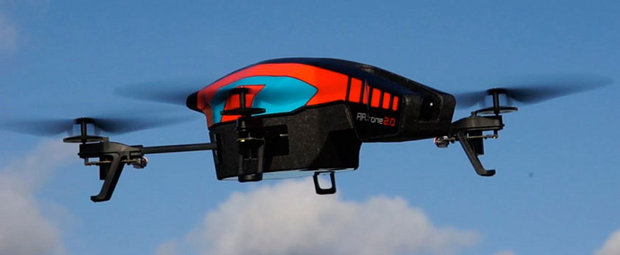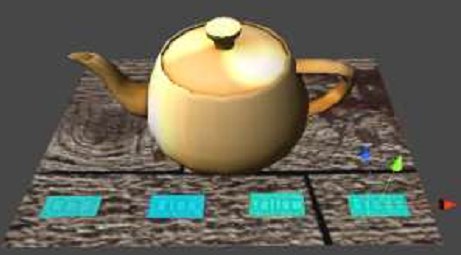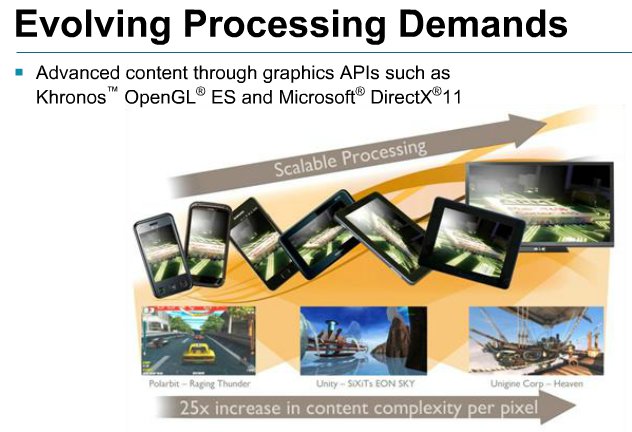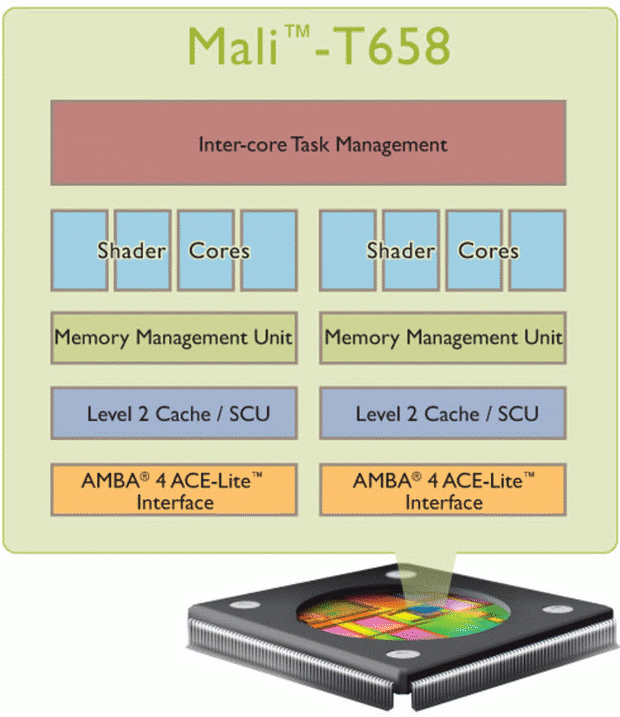Parrot announced a revised version of its Linux-based Parrot AR Drone “quadricopter” flying drone at CES 2012. The drone can now be operated with any Android device such as smartphones and tablets, whereas the previous version could only be controlled by an iPhone or iPad. Another new software features is the auto-pilot. The quadricopter body has been redesigned and reinforced, and fitted with a new 720p HD front-facing navigational camera which can record video and help the pilot navigating the drone. There is also a vertical camera that was present in the first generation. Here are the technical specializations of the Drone’s motherboard: 1 GHz 32-bit ARM Cortex A8 processor (Maybe OMAP3?) 800Mhz video DSP (TMS320DMC64x) 1GB DDR2 RAM USB 2.0 WiFi b/g/n . 3-axis accelerometer 3-axis gyroscope 3-axis magnetometer Pressure sensor for altitude measurement (altitude > 6m) Ultrasound sensor for ground altitude measurement (lower altitude) 60fps vertical QVGA camera […]
Vuforia: Qualcomm Augmented Reality Platform
Qualcomm named its Augmented Reality Platform “VuForia” at CES 2012. I was a bit confused reading the press release and thought it was a new product. Actually, it is the augmented reality platform whose Beta SDK has been released in December 2011. Qualcomm explains that “Vuforia’s computer vision functionality will recognize a variety of 2D and 3D visual targets. With support for iOS, Android, and Unity 3D, Vuforia will allow you to write a single native app that can reach over 400 models of smartphones and tablets.” To showcase the AR platform, Qualcomm and Sesame Workshop, the producer behind Sesame Street, have joined forces to explore augmented reality experiences for children and created a prototype playset that brings physical toys to life. Jean-Luc Aufranc (CNXSoft)Jean-Luc started CNX Software in 2010 as a part-time endeavor, before quitting his job as a software engineering manager, and starting to write daily news, and […]
Metaio Releases Mobile Augmented Reality SDK
Yesterday Qualcomm released QCAR SDK 1.5 Beta, and today Metaio announces its Mobile SDK 3.0 for augmented reality application development on Android and iOS. The metaio Mobile SDK brings with it patented gravity-awareness and visual tracking technology for 2D and 3D objects, now three times more robust than the previous version. These features combined will ensure AR experiences that are more natural, more intuitive, and more realistic, says the company. Metaio recently announced formal collaborations with ARM, ST-Ericsson and Texas Instruments to fully take advantage of the GPU hardware provided by those companies and the Mobile SDK is optimized for ARM Mali GPU (both graphics and compute), ST Ericsson Nova and NovaThor mobile processors and TI OMAP processors. The metaio Mobile SDK also includes its own 3D rendering engine – now with advanced shader support – and a plugin to make use of Unity3D (3D game engine). You can watch […]
Qualcomm Releases Augmented Reality SDK 1.5 Beta for Android
Qualcomm has just announced the availability of QCAR SDK version 1.5 Beta 1 for Android. is now available for download. The Key features and improvements in this version of the QCAR SDK include: Video background texture access: The SDK now provides a simple and streamlined way of accessing the video background texture. Developers can now write custom special effects using powerful shaders resulting in far more exciting application experiences. Swapping datasets at runtime: If your app needs to augment more than 60 images, you can now create multiple datasets – using the web-based Target Management System (My Trackables tool)- and load the appropriate dataset at runtime. You no longer have to upgrade your app to change the target dataset, and you can now build AR experiences that work on a large number of images. Improved tracking performance: The new SDK features several enhancements that reduce jitter in the augmentations, speed […]
Midgard architecture for Embedded GPUs (Mali-T604 / Mali T658)
I’ve attended a webinar entitled “Harness the power and flexibility of the Midgard architecture for Embedded GPUs” presented Steve Steele, Product Manager at ARM Media Processing Division and sponsored by EETimes. Steve starts to talk about the current GPU architecture “Utgard” used in Mali-200, Mali-300 and Mali-400MP which allows resolutions up to 1080p and are used in many smartphones today including Samsung Galaxy S2 (Mali-400MP) which provides great graphics performance. He then explains how mobile devices are used today and what performance we may except in the future: Mobile As Main compute platform: New UI and Augmented Reality Social Networks and emails Content Creation/consumption 1 Device to multiple screen (e.g LCD screen and TV via HDMI) Evolving Processing Demand: Graphics Complexity multiplied by 25 Increase in screen size (1080p resolution support). Graphics API: Khronos OpenGL ES, Microsoft DirectX 11 Compute API: OpenCL, Renderscript Compute and Direct Compute. After this overview, […]
ARM Announces New Mali-T658 GPU
About one year ago, ARM announced the Mali-T604 GPU which has yet to be used in current products. Yet today, ARM announced an even more powerful GPU called Mali-T658 in Tokyo at Japan ARM Technical Symposium. Mali T658 is based on Midgard GPU architecture (as is Mali T604) which allows great GPGPU capabilities thanks to three types of pipeline (‘tri-pipe’) optimized repetitively for arithmetic, load/store and texturing. The GPU will also support standard graphics APIs such as Khronos OpenGL ES, OpenVG andMicrosoft DirectX® 11) as well as Compute APIs such as Khronos OpenCL (Full Profile), Google RenderScript compute and Microsoft DirectCompute. Performance-wise, Mali-T658 has twice as many shader cores and double the arithmetic pipelines per core which means the GPU can offer up to 10 times the performance of the Mali-400 MP GPU. On the compute side, Mali-T658 provides 4 times the processing power of Mali-T604. Mali-T658 will work with […]
National Geographic Augmented Reality Application
Impressive Augmented Reality Live Broadcast: Shoppers walk by a large screen in a mall where they can see themselves with wild animals, dinosaurs and walk with astronauts. This Augmented Reality system has been designed by AppShaker, a “digital creative agency devoted to building the finest online experiences for brands across the world”. You can also go to their website to watch their other projects. I suspect the augmented reality system above is based on a PC system. Jean-Luc Aufranc (CNXSoft)Jean-Luc started CNX Software in 2010 as a part-time endeavor, before quitting his job as a software engineering manager, and starting to write daily news, and reviews full time later in 2011. www.cnx-software.com
Qualcomm Fast Computer Vision SDK
Qualcomm introduced FastCV (Fast Computer Vision), a mobile-optimized computer vision (CV) library that includes the most frequently used vision processing functions for use across a wide array of Android mobile devices. FastCV provides computationally intensive vision processing APIs, with hardware acceleration and better performance on mobile devices. FastCV is designed for efficiency on all ARM-based processors, but is also especially tuned to take advantage of Qualcomm’s Snapdragon processors (Qualcomm S2 and above). That’s because FastCV for Snapdragon can offload processing onto various subsystems within the processor, whereas FastCV for ARM is limited to acceleration on the CPU. FastCV is the framework at the heart of Qualcomm’s vision-based Augmented Reality (AR) SDK, because AR is much more precise and useful when it’s based on camera input than on location-based estimates. Qualcomm anticipates that FastCV will be used to build additional frameworks that will allow developers of computer vision apps to build […]









